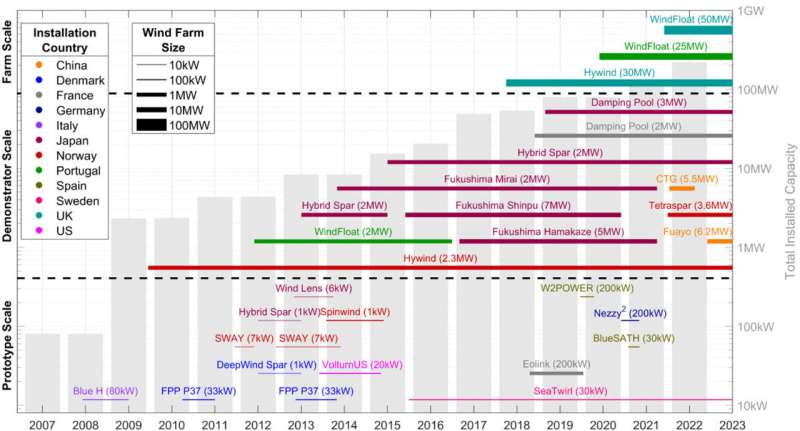
The UK’s renewable energy sector is well placed to take advantage of the expected boom in floating offshore wind technology, a new study suggests.
Writing in the Renewable and Sustainable Energy Reviews journal, researchers from the University of Plymouth highlight that huge advances in platform technology have taken place over the past two decades.
This has led to a shift from early designs, which reflected those used in the oil and gas industry and focused predominantly on platform stability, to more specialized designs introduced in significant part driven by the need to reduce costs.
These bespoke designs are being developed alongside a more holistic view of the platform’s place within the local environment, including aspects such as local economy, infrastructure, and particularly impact on the marine environment.
For the sector’s potential to be fully maximized, however, researchers say there are still a number of challenges that need to be overcome in terms of design, cost, infrastructure and maintenance.
They also add that greater consideration of—and investment in—a UK-based supply chain will be essential to ensure the UK’s economy as a whole benefits from the floating offshore wind revolution.
The study, by researchers from the University’s Centre for Decarbonisation and Offshore Renewable Energy (C-DORE), highlights that the floating offshore wind industry—which is just starting to reach commercial success—is set to dramatically expand.
Between now and 2050, the global floating offshore wind sector will need to grow in installed capacity by a staggering 2000%, from the current 121MW to around 264GW.
To try and meet that demand, most platforms currently being tested at sea fit into four categories—spars, which have a single vertical cylinder with ballast at the bottom; semi-submersibles, consisting of three to five vertical cylinders connected together, with the turbine in the center or above one of the columns; tension leg platforms, which rely on taut mooring lines connected to the seabed for stability; and barges, which are wide, shallow platforms.
Platforms such as this are expected to form the basis of the sector’s growth in UK waters, which will be centered around Scotland and the Celtic Sea, with the Crown Estate scheduled to open its next leasing round for the latter in 2023.
“The potential sites for UK floating offshore wind installations are quite different to those found elsewhere in the world. In the United States and Japan, for example, the waters where these platforms could be sited are up to 1,000m deep whereas the target sites in the UK are only around 60–120m.”
“That has led to the focus on two specific types of platform we are now seeing tested at sea—semi-submersibles and barges—as they seem particularly well suited to the UK’s ocean and seabed conditions. Over the next few years, it will be critical that these designs continue to be improved—both from an energy generation and cost perspective—to meet the UK’s ambitious 2030 and 2050 Net Zero goals,” says Emma Edwards, Research Fellow in ORE Hydrodynamics.
More information:
Emma C. Edwards et al, Evolution of floating offshore wind platforms: A review of at-sea devices, Renewable and Sustainable Energy Reviews (2023). DOI: 10.1016/j.rser.2023.113416
Citation:
Study highlights significant design advances across floating offshore wind sector (2023, September 8)
retrieved 9 September 2023
from https://techxplore.com/news/2023-09-highlights-significant-advances-offshore-sector.html
This document is subject to copyright. Apart from any fair dealing for the purpose of private study or research, no
part may be reproduced without the written permission. The content is provided for information purposes only.
Stay connected with us on social media platform for instant update click here to join our Twitter, & Facebook
We are now on Telegram. Click here to join our channel (@TechiUpdate) and stay updated with the latest Technology headlines.
For all the latest Technology News Click Here
For the latest news and updates, follow us on Google News.
